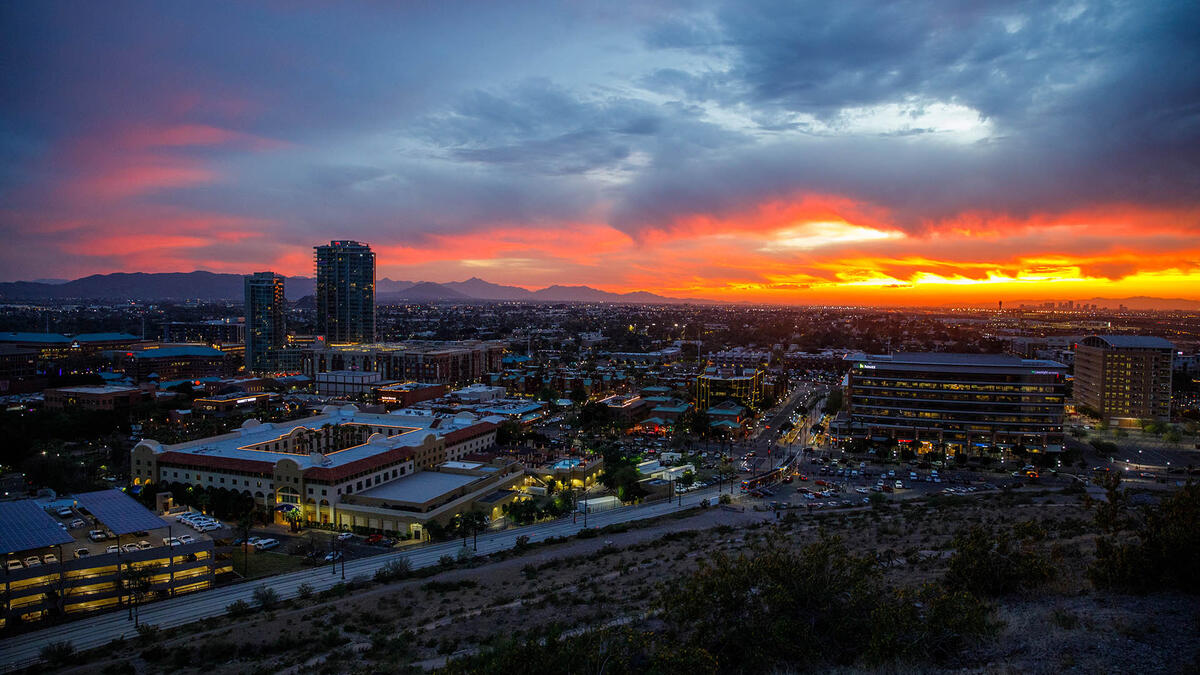Arizona energy providers, state universities join forces to pursue a carbon-neutral economy

Four Arizona energy providers and the state’s three public universities are forming a new, interdisciplinary coalition with the goal of attaining a carbon-neutral economy in Arizona.
Faced with the complexity of reducing carbon dioxide (CO2) emissions across economic sectors, and the urgency to respond to the climate crisis, this coalition will combine its expertise to launch a new center to begin working immediately on strategies and solutions.
Leading professionals from Arizona Public Service, Salt River Project, Tucson Electric Power and Southwest Gas, as well as from Arizona State University, the University of Arizona and Northern Arizona University, will play a crucial leadership role in helping Arizona explore options and strategic pathways that move the state toward a carbon-neutral and thriving economy.
To begin, the coalition established a new ASU-based center called the “Center for an Arizona Carbon-Neutral Economy,” housed within the Julie Ann Wrigley Global Futures Laboratory on the ASU Tempe campus. Among its first undertakings, the center will pursue the creation of a regional clean hydrogen hub.
“ASU’s Global Futures Laboratory exists precisely to take on the challenge of creating a future of opportunity,” said Peter Schlosser, vice president and vice provost of the Julie Ann Wrigley Global Futures Laboratory at ASU. “We welcome the establishment of this new center, and we are eager to work with the brightest minds from Arizona’s leading energy companies and our sister universities to explore the most effective ways to develop a sustainable and thriving carbon neutral economy.”
“The need to address the causes and impacts of climate change has never been more important. By partnering with Arizona’s universities and peer utilities, this statewide hub will help advance hydrogen as a clean-energy solution with tremendous potential to accelerate decarbonization,” said Jeff Guldner, Arizona Public Service chairman, president and CEO. “It also will further Arizona’s reputation as a national leader in the clean energy transition while creating economic opportunities for our state and its people.”
“NAU has a long legacy of leadership and commitment to sustainability, and this new partnership creates incredible opportunities for our students, faculty and staff to help tackle the important work of creating a carbon-neutral future for Arizona,” said Jason Wilder, NAU vice president for research. "We’re thrilled to be able to help design a cleaner economy that will sustain Arizona into the future and to train the workforce that will be essential to bring these innovations into practice.”
Hydrogen can fuel chemical reactions that release clean energy and produce only water – H2O, not CO2. That means much of the energy used to create pure hydrogen can be essentially “stored” in the gas itself and used to provide carbon-free energy or feedstock on demand. Tapping this potential could help reduce carbon emissions in many sectors of the economy.
In late October 2021, the U.S. Congress passed the bipartisan Infrastructure Investment and Jobs Act, which the president signed in mid-November 2021. The law establishes program guidance and funding to create regional clean hydrogen hubs, which the coalition will seek. The clean hydrogen hub, while still being fully defined, will include hydrogen producers, consumers and a connected infrastructure so that supply and demand are in sync and appropriately buffered with storage.
“The development of a regional clean hydrogen hub could provide critical support for our ongoing transition to a cleaner, cleaner grid,” said Susan Gray, president and CEO of Tucson Electric Power and its parent company, UNS Energy. “We’re looking forward to working together to turn this vision into real, sustainable growth for Arizona’s economy.”
A successful regional clean hydrogen hub would help address difficult-to-reduce carbon dioxide emissions in the state, as well as grow Arizona’s economy, attract new businesses and create high-quality jobs. When fully operational, a new hub would help support a reliable and resilient electric grid, provide clean energy for the electric, transportation and industrial sectors, and potentially create economic development opportunities in communities that are adversely impacted by the closure of fossil-fueled plants.
Involving these communities in the process is a critical component of the coalition’s work. By engaging a wide range of diverse stakeholders, the group will develop a shared strategy to create a new hydrogen ecosystem and industry in Arizona. Stakeholders will be part of a collaborative network that directly involves communities, tribes, businesses, universities, government agencies, nonprofit organizations and other interested parties in the process.
“This challenge is bigger than any one company or industry. SRP appreciates the support and vision of this diverse set of partners willing to roll up their sleeves, work together and find solutions to become a low-net-carbon Arizona,” said Mike Hummel, CEO and general manager of Salt River Project.
“Southwest Gas is committed to helping our customers and the communities we serve achieve emissions reductions goals. Advancing hydrogen technology and increasing availability of hydrogen to the market is strategically important to achieving our clean energy goals. With existing infrastructure that can be used to transport this powerful clean fuel, Southwest Gas is excited to work with this coalition and stakeholders to lead efforts to bring a regional hydrogen hub to our state,” said Laura Nelson, vice president of sustainability and public policy for Southwest Gas.
“Arizona has tremendous potential to lower greenhouse gas emissions by producing clean-burning hydrogen using solar energy,” Sen. Mark Kelly said. “I look forward to working with the coalition to increase hydrogen production in our state.”
Collectively defining the vision, governance and organizational structure for the hub requires a deeper dive into a myriad of assets and resources available in the state, and this effort is already underway.
“The University of Arizona is dedicated to a future for Arizona that is both economically and environmentally resilient. The new coalition as well as the Center for an Arizona Carbon-Neutral Economy will help create and secure that future,” said Elizabeth “Betsy” Cantwell, UArizona senior vice president for research and innovation. “We are thrilled to partner with our fellow state universities and local utilities to leverage the power of our place in a living laboratory and create scalable infrastructure for a clean, resilient Arizona.”
Arizona is one of the nation's sunniest states, with significant available undeveloped land and abundant clean energy resources. It has the largest nuclear power plant in the nation, energy providers that have committed to reduce carbon dioxide emissions, world-class innovative universities, an established and growing industry base, and a healthy environment for innovation and startups.
These resources, along with the region’s highly skilled workforce, can be used in producing, moving, storing and using hydrogen. While Arizona is currently a net energy importer, these assets could help the state become an energy exporter, bolstering its economy and helping others’ efforts to achieve their clean energy goals.
“Today’s partnership will pave the way towards a carbon-neutral economy by 2050, creating the jobs of the future and fueling innovation and sustainable energy sources throughout our state,” Arizona senior Sen. Kyrsten Sinema said.
Top photo courtesy Arizona State University.
More Science and technology

The Polytechnic School at ASU hits milestone mark at 10 years
The year was 2014.Taylor Swift released “1989.” "Frozen” and its soundtrack were stuck in the minds of many.Facebook was still the most popular social media site, and “Happy” by Pharrell…

Study finds cerebellum plays role in cognition — and it's different for males and females
Research has shown there can be sex differences for how male and female brains are wired.For example, links have been made between neurobehavioral diseases — such as attention-deficit/hyperactivity…

Artificial intelligence drives need for real data storage innovations
In southeastern Mesa, Arizona, construction crews are hard at work on a state-of-the-art data center. The $1 billion facility will open in 2026 and provide approximately 2.5 million square feet…

